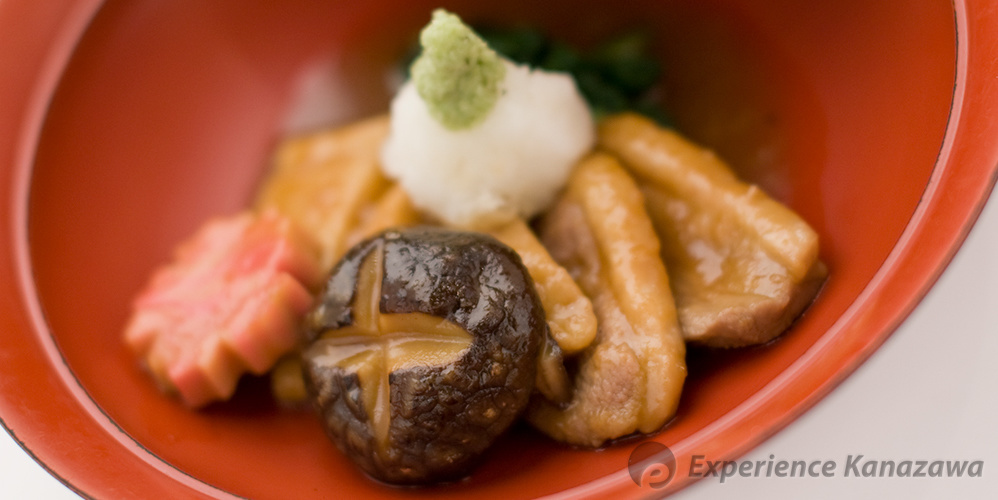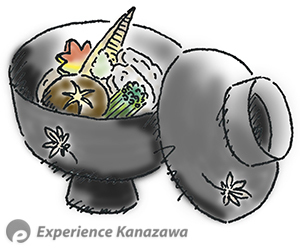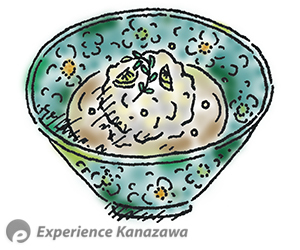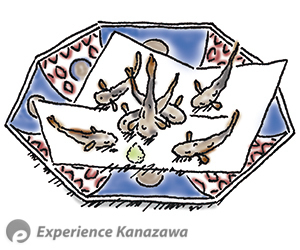Kaga-Ryori: The Traditional Local dishes

Must-eat cuisine
When you travel to other cities, you definitely expect to find a local food that can only be eaten in the region, right? Well, let me introduce some local dishes in order for you not to be at a loss in the restaurant. Kaga-ryori is an original cuisine which utilizes seafood, vegetables, and ingredients from the local Kanazawa area. Jibuni, Hasumushi and gori-karaage are three popular Kaga-ryori dishes. These dishes are usually served on colorful Kutani porcelain, or lacquerware made in Ishikawa, and taste as excellent as they look!
Coco SHIZUO, Artex Inc.; Updated June 1, 2018
Jibuni: Duck Simmered in a Flovorful broth and Accompanied with Vegetables

Jibuni is the most well-known dish of Kaga-ryori. For all that utilizing duck meat is the original, sometimes chicken is substituted instead. The duck is coated in flour or potato starch and then placed in a boiling broth that results in a thick and golden coating. Other ingredients such as sudare-fu (wheat gluten), shiitake mushrooms, carrots and seri (Japanese parsley) are well-simmered in the flavorful broth. The origins of the name are unclear. Some say our first lord, Toshiie Maeda was served a similar duck dish by Mitsunari Ishida, who was one of the five commissioners during 16th century.
Then later Toshiie had it re-prepared by his own chef. At that time, Mitsunari worked for the "Jibu-sho" division, so Jibuni was named after his court title.
Hasu-mushi: Steamed Minced Lotus Root in a Thick Sauce

Gori-kara-age: Deep Fried ‘Gori’ Fish Seasoned with Salt

Gori are very tiny freshwater fish. In Kanazawa, we refer to both the 'Japanese fluvial sculpin' caught at the Asanogawa and the Saigawa rivers, and 'goby' at the Kahokugata lagoon. Fishing used to thrive from the Edo period to the beginning of Showa, but not any more. As a result, the dishes are also getting rarer and harder to find. Deep-frying makes the whole fish body crispy. It's easy to eat the whole thing, including the bones! Such a dish obviously goes well with beer. Order it as an appetizer if you have the good luck to find it at an izakaya restaurant!
Jibuni: Duck Simmered in a Flovorful broth
and Accompanied with Vegetables

Jibuni is the most well-known dish of Kaga-ryori. For all that utilizing duck meat is the original, sometimes chicken is substituted instead. The duck is coated in flour or potato starch and then placed in a boiling broth that results in a thick and golden coating. Other ingredients such as sudare-fu (wheat gluten), shiitake mushrooms, carrots and seri (Japanese parsley) are well-simmered in the flavorful broth. The origins of the name are unclear. Some say our first lord, Toshiie Maeda was served a similar duck dish by Mitsunari Ishida, who was one of the five commissioners during 16th century.
Then later Toshiie had it re-prepared by his own chef. At that time, Mitsunari worked for the "Jibu-sho" division, so Jibuni was named after his court title.
Hasu-mushi: Steamed Minced Lotus Root
in a Thick Sauce

Kaga-renkon is one of the region’s indigenous vegetables. Hasu means lotus in Japanese, and the lotus root is utilized for the dish. A mixture of minced lotus root and the white of an egg are steamed with some mushrooms, chopped prawns, sliced lily bulbs, and white fish meat, and then mixed with a thick sauce. The sauce has the slight aroma of soy.
Gori-kara-age: Deep Fried ‘Gori’ Fish
Seasoned with Salt

Gori are very tiny freshwater fish. In Kanazawa, we refer to both the 'Japanese fluvial sculpin' caught at the Asanogawa and the Saigawa rivers, and 'goby' at the Kahokugata lagoon. Fishing used to thrive from the Edo period to the beginning of Showa, but not any more. As a result, the dishes are also getting rarer and harder to find. Deep-frying makes the whole fish body crispy. It's easy to eat the whole thing, including the bones! Such a dish obviously goes well with beer. Order it as an appetizer if you have the good luck to find it at an izakaya restaurant!
Kanazawa Area
Kenrokuenn Garden
Following Matsuo Bashô’s steps in Ishikawa - 1/6 [Introduction]
Following Matsuo Bashô’s steps in Ishikawa - 2/6 [Kanazawa]
Noto Area
Mitsukejima Island
Kaga Area
Following Matsuo Bashô’s steps in Ishikawa - 3/6 [Komatsu City]
Following Matsuo Bashô’s steps in Ishikawa - 4/6 [Natadera Temple]
Following Matsuo Bashô’s steps in Ishikawa - 5/6 [Yamanaka Onsen Town]
Following Matsuo Bashô’s steps in Ishikawa - 6/6 [Daishoji District]
Rosanjin in Yamashiro Onsen Town
Stroll Kanazawa in Rental Kimono - 1/2 [Kimono Rental]
Stroll Kanazawa in Rental Kimono - 2/2 [Kimono Stroll]
January
Enyukai: Geisha Party
February
Setsubun-Sai Festival
AUGUST
Issaki Hoh-Toh Matsuri
November
Enyukai: Geisha Party
